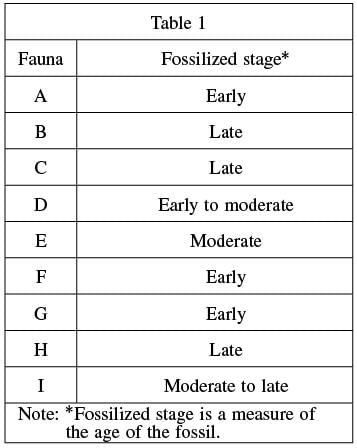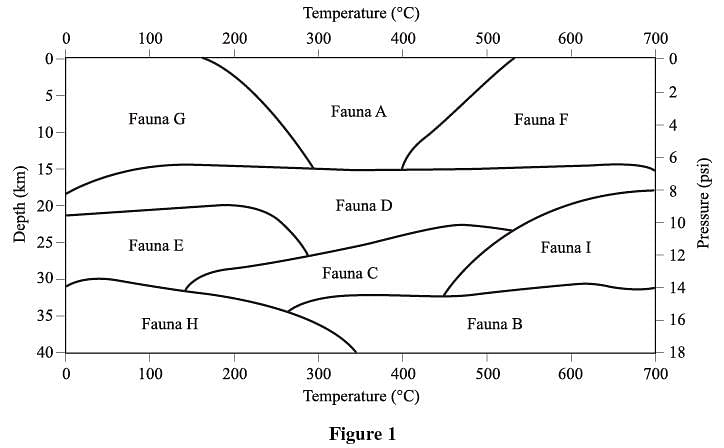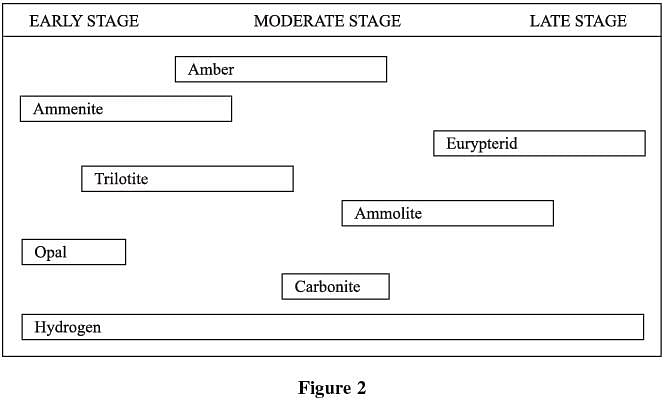ACT Exam > ACT Questions > Directions:Read the passages and choose the b...
Start Learning for Free
Directions: Read the passages and choose the best answer to each question.
Passage
Sedimentary layers form when changes in the environment cause changes in the top soil of the area. As pressure is applied from the additional layers, fossils are formed.
Figure 1 shows the different depths and pressure conditions under which different Fauna (categories of fossils) are formed.
A fossil’s formation stage (a measure of the age of the fossil) is classified on a scale of early (first recovered) to late (deeply buried). Table 1 lists the grades of Fauna A–I from Figure 1. Figure 2 shows characteristic compounds that may be found in fossils of a given stage.



Passage
Sedimentary layers form when changes in the environment cause changes in the top soil of the area. As pressure is applied from the additional layers, fossils are formed.
Figure 1 shows the different depths and pressure conditions under which different Fauna (categories of fossils) are formed.
A fossil’s formation stage (a measure of the age of the fossil) is classified on a scale of early (first recovered) to late (deeply buried). Table 1 lists the grades of Fauna A–I from Figure 1. Figure 2 shows characteristic compounds that may be found in fossils of a given stage.



Q. According to Figure 2, the presence of which of the following compounds in a fossil is the least helpful when determining the fossil’s stage?
- a)Hydrogen
- b)Trilotite
- c)Amber
- d)Eurypterid
Correct answer is option 'A'. Can you explain this answer?
Most Upvoted Answer
Directions:Read the passages and choose the best answer to each questi...
The best answer is A. Figure 2 shows the characteristic compounds that may be found in fossils at a given stage. Hydrogen appears in fossils at all stages, and therefore, will not be helpful in determining a fossil’s stage; this information best supports answer choice A.

|
Explore Courses for ACT exam
|

|
Directions:Read the passages and choose the best answer to each question.PassageSedimentary layers form when changes in the environment cause changes in the top soil of the area. As pressure is applied from the additional layers, fossils are formed.Figure 1 shows the different depths and pressure conditions under which different Fauna (categories of fossils) are formed.A fossil’s formation stage (a measure of the age of the fossil) is classified on a scale of early (first recovered) to late (deeply buried). Table 1 lists the grades of Fauna A–I from Figure 1. Figure 2 shows characteristic compounds that may be found in fossils of a given stage.Q. According to Figure 2, the presence of which of the following compounds in a fossil is the least helpful when determining the fossil’s stage?a)Hydrogenb)Trilotitec)Amberd)EurypteridCorrect answer is option 'A'. Can you explain this answer?
Question Description
Directions:Read the passages and choose the best answer to each question.PassageSedimentary layers form when changes in the environment cause changes in the top soil of the area. As pressure is applied from the additional layers, fossils are formed.Figure 1 shows the different depths and pressure conditions under which different Fauna (categories of fossils) are formed.A fossil’s formation stage (a measure of the age of the fossil) is classified on a scale of early (first recovered) to late (deeply buried). Table 1 lists the grades of Fauna A–I from Figure 1. Figure 2 shows characteristic compounds that may be found in fossils of a given stage.Q. According to Figure 2, the presence of which of the following compounds in a fossil is the least helpful when determining the fossil’s stage?a)Hydrogenb)Trilotitec)Amberd)EurypteridCorrect answer is option 'A'. Can you explain this answer? for ACT 2025 is part of ACT preparation. The Question and answers have been prepared according to the ACT exam syllabus. Information about Directions:Read the passages and choose the best answer to each question.PassageSedimentary layers form when changes in the environment cause changes in the top soil of the area. As pressure is applied from the additional layers, fossils are formed.Figure 1 shows the different depths and pressure conditions under which different Fauna (categories of fossils) are formed.A fossil’s formation stage (a measure of the age of the fossil) is classified on a scale of early (first recovered) to late (deeply buried). Table 1 lists the grades of Fauna A–I from Figure 1. Figure 2 shows characteristic compounds that may be found in fossils of a given stage.Q. According to Figure 2, the presence of which of the following compounds in a fossil is the least helpful when determining the fossil’s stage?a)Hydrogenb)Trilotitec)Amberd)EurypteridCorrect answer is option 'A'. Can you explain this answer? covers all topics & solutions for ACT 2025 Exam. Find important definitions, questions, meanings, examples, exercises and tests below for Directions:Read the passages and choose the best answer to each question.PassageSedimentary layers form when changes in the environment cause changes in the top soil of the area. As pressure is applied from the additional layers, fossils are formed.Figure 1 shows the different depths and pressure conditions under which different Fauna (categories of fossils) are formed.A fossil’s formation stage (a measure of the age of the fossil) is classified on a scale of early (first recovered) to late (deeply buried). Table 1 lists the grades of Fauna A–I from Figure 1. Figure 2 shows characteristic compounds that may be found in fossils of a given stage.Q. According to Figure 2, the presence of which of the following compounds in a fossil is the least helpful when determining the fossil’s stage?a)Hydrogenb)Trilotitec)Amberd)EurypteridCorrect answer is option 'A'. Can you explain this answer?.
Directions:Read the passages and choose the best answer to each question.PassageSedimentary layers form when changes in the environment cause changes in the top soil of the area. As pressure is applied from the additional layers, fossils are formed.Figure 1 shows the different depths and pressure conditions under which different Fauna (categories of fossils) are formed.A fossil’s formation stage (a measure of the age of the fossil) is classified on a scale of early (first recovered) to late (deeply buried). Table 1 lists the grades of Fauna A–I from Figure 1. Figure 2 shows characteristic compounds that may be found in fossils of a given stage.Q. According to Figure 2, the presence of which of the following compounds in a fossil is the least helpful when determining the fossil’s stage?a)Hydrogenb)Trilotitec)Amberd)EurypteridCorrect answer is option 'A'. Can you explain this answer? for ACT 2025 is part of ACT preparation. The Question and answers have been prepared according to the ACT exam syllabus. Information about Directions:Read the passages and choose the best answer to each question.PassageSedimentary layers form when changes in the environment cause changes in the top soil of the area. As pressure is applied from the additional layers, fossils are formed.Figure 1 shows the different depths and pressure conditions under which different Fauna (categories of fossils) are formed.A fossil’s formation stage (a measure of the age of the fossil) is classified on a scale of early (first recovered) to late (deeply buried). Table 1 lists the grades of Fauna A–I from Figure 1. Figure 2 shows characteristic compounds that may be found in fossils of a given stage.Q. According to Figure 2, the presence of which of the following compounds in a fossil is the least helpful when determining the fossil’s stage?a)Hydrogenb)Trilotitec)Amberd)EurypteridCorrect answer is option 'A'. Can you explain this answer? covers all topics & solutions for ACT 2025 Exam. Find important definitions, questions, meanings, examples, exercises and tests below for Directions:Read the passages and choose the best answer to each question.PassageSedimentary layers form when changes in the environment cause changes in the top soil of the area. As pressure is applied from the additional layers, fossils are formed.Figure 1 shows the different depths and pressure conditions under which different Fauna (categories of fossils) are formed.A fossil’s formation stage (a measure of the age of the fossil) is classified on a scale of early (first recovered) to late (deeply buried). Table 1 lists the grades of Fauna A–I from Figure 1. Figure 2 shows characteristic compounds that may be found in fossils of a given stage.Q. According to Figure 2, the presence of which of the following compounds in a fossil is the least helpful when determining the fossil’s stage?a)Hydrogenb)Trilotitec)Amberd)EurypteridCorrect answer is option 'A'. Can you explain this answer?.
Solutions for Directions:Read the passages and choose the best answer to each question.PassageSedimentary layers form when changes in the environment cause changes in the top soil of the area. As pressure is applied from the additional layers, fossils are formed.Figure 1 shows the different depths and pressure conditions under which different Fauna (categories of fossils) are formed.A fossil’s formation stage (a measure of the age of the fossil) is classified on a scale of early (first recovered) to late (deeply buried). Table 1 lists the grades of Fauna A–I from Figure 1. Figure 2 shows characteristic compounds that may be found in fossils of a given stage.Q. According to Figure 2, the presence of which of the following compounds in a fossil is the least helpful when determining the fossil’s stage?a)Hydrogenb)Trilotitec)Amberd)EurypteridCorrect answer is option 'A'. Can you explain this answer? in English & in Hindi are available as part of our courses for ACT.
Download more important topics, notes, lectures and mock test series for ACT Exam by signing up for free.
Here you can find the meaning of Directions:Read the passages and choose the best answer to each question.PassageSedimentary layers form when changes in the environment cause changes in the top soil of the area. As pressure is applied from the additional layers, fossils are formed.Figure 1 shows the different depths and pressure conditions under which different Fauna (categories of fossils) are formed.A fossil’s formation stage (a measure of the age of the fossil) is classified on a scale of early (first recovered) to late (deeply buried). Table 1 lists the grades of Fauna A–I from Figure 1. Figure 2 shows characteristic compounds that may be found in fossils of a given stage.Q. According to Figure 2, the presence of which of the following compounds in a fossil is the least helpful when determining the fossil’s stage?a)Hydrogenb)Trilotitec)Amberd)EurypteridCorrect answer is option 'A'. Can you explain this answer? defined & explained in the simplest way possible. Besides giving the explanation of
Directions:Read the passages and choose the best answer to each question.PassageSedimentary layers form when changes in the environment cause changes in the top soil of the area. As pressure is applied from the additional layers, fossils are formed.Figure 1 shows the different depths and pressure conditions under which different Fauna (categories of fossils) are formed.A fossil’s formation stage (a measure of the age of the fossil) is classified on a scale of early (first recovered) to late (deeply buried). Table 1 lists the grades of Fauna A–I from Figure 1. Figure 2 shows characteristic compounds that may be found in fossils of a given stage.Q. According to Figure 2, the presence of which of the following compounds in a fossil is the least helpful when determining the fossil’s stage?a)Hydrogenb)Trilotitec)Amberd)EurypteridCorrect answer is option 'A'. Can you explain this answer?, a detailed solution for Directions:Read the passages and choose the best answer to each question.PassageSedimentary layers form when changes in the environment cause changes in the top soil of the area. As pressure is applied from the additional layers, fossils are formed.Figure 1 shows the different depths and pressure conditions under which different Fauna (categories of fossils) are formed.A fossil’s formation stage (a measure of the age of the fossil) is classified on a scale of early (first recovered) to late (deeply buried). Table 1 lists the grades of Fauna A–I from Figure 1. Figure 2 shows characteristic compounds that may be found in fossils of a given stage.Q. According to Figure 2, the presence of which of the following compounds in a fossil is the least helpful when determining the fossil’s stage?a)Hydrogenb)Trilotitec)Amberd)EurypteridCorrect answer is option 'A'. Can you explain this answer? has been provided alongside types of Directions:Read the passages and choose the best answer to each question.PassageSedimentary layers form when changes in the environment cause changes in the top soil of the area. As pressure is applied from the additional layers, fossils are formed.Figure 1 shows the different depths and pressure conditions under which different Fauna (categories of fossils) are formed.A fossil’s formation stage (a measure of the age of the fossil) is classified on a scale of early (first recovered) to late (deeply buried). Table 1 lists the grades of Fauna A–I from Figure 1. Figure 2 shows characteristic compounds that may be found in fossils of a given stage.Q. According to Figure 2, the presence of which of the following compounds in a fossil is the least helpful when determining the fossil’s stage?a)Hydrogenb)Trilotitec)Amberd)EurypteridCorrect answer is option 'A'. Can you explain this answer? theory, EduRev gives you an
ample number of questions to practice Directions:Read the passages and choose the best answer to each question.PassageSedimentary layers form when changes in the environment cause changes in the top soil of the area. As pressure is applied from the additional layers, fossils are formed.Figure 1 shows the different depths and pressure conditions under which different Fauna (categories of fossils) are formed.A fossil’s formation stage (a measure of the age of the fossil) is classified on a scale of early (first recovered) to late (deeply buried). Table 1 lists the grades of Fauna A–I from Figure 1. Figure 2 shows characteristic compounds that may be found in fossils of a given stage.Q. According to Figure 2, the presence of which of the following compounds in a fossil is the least helpful when determining the fossil’s stage?a)Hydrogenb)Trilotitec)Amberd)EurypteridCorrect answer is option 'A'. Can you explain this answer? tests, examples and also practice ACT tests.

|
Explore Courses for ACT exam
|

|
Signup for Free!
Signup to see your scores go up within 7 days! Learn & Practice with 1000+ FREE Notes, Videos & Tests.
























